
|
Sale 102
NY International Coin Auction January 9-11, 2018
| Lot |
Photo |
Description |
Realized |
Lot 1 |
 |
Eastern Europe. Imitating Philip II of Macedon. Silver Tetradrachm (14.06 g), 3rd-2nd centuries BC. 'Baumreiter' type. Laureate head of Zeus right. rev. Horseman riding left, holding branch; symbols before and below. CCCBM 65; Kostial 416 (same dies); OTA 129/2. Well struck in high relief. Toned. About Extremely Fine. Estimated Value $1,500
From the Dr. Patrick Tan Collection
Ex Leu 79 (31 October 2000), 129;
Ex John W. Garrett Collection, pt. II (NFA / Leu, 16 October 1984), 70.
View details and enlarged photos
| Realized
$4,248 |
Lot 2 |
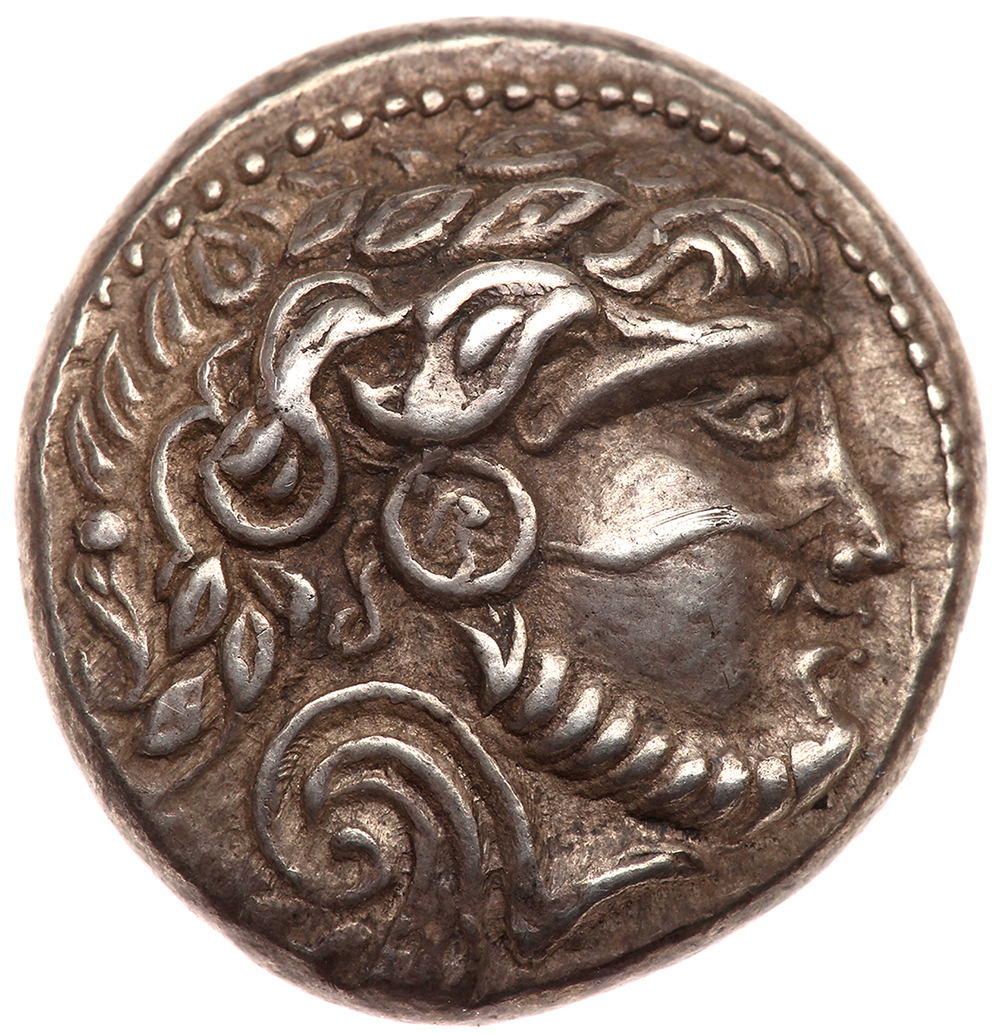 |
Celtic Pannonia. Silver Tetradrachm (14.22g), 2nd-1st centuries BC Superb EF. Imitation of Philip II of Macedon. Celticized head of Zeus bearded right. rev. Two horsemen prancing right, one a bearded male the other a youth. Kostial 410. Boldly struck in high relief. A very impressive Celtic issue. Attractive antique tone. Superb Extremely Fine. Estimated Value $2,000
Private purchase from Edward J. Waddell, Ltd.
View details and enlarged photos
| Realized
$4,720 |
Lot 3 |
 |
Eastern Europe, Imitating Philip III. Silver Tetradrachm (17.08 g), 2nd century BC. Head of Herakles right, wearing lion's skin headdress. rev. BIΛΣIΛEΩ[Σ] ΦIΛIΠΠO[Y], Zeus seated left, holding eagle and scepter; in left field, two monograms of same type, the uppoer one in a circle; Z below throne. Cf. Kostial 898 (upper monogram); CCCBM I 192. Lightly toned. Extremely Fine. Estimated Value $300
View details and enlarged photos
| Realized
$384 |
Lot 4 |
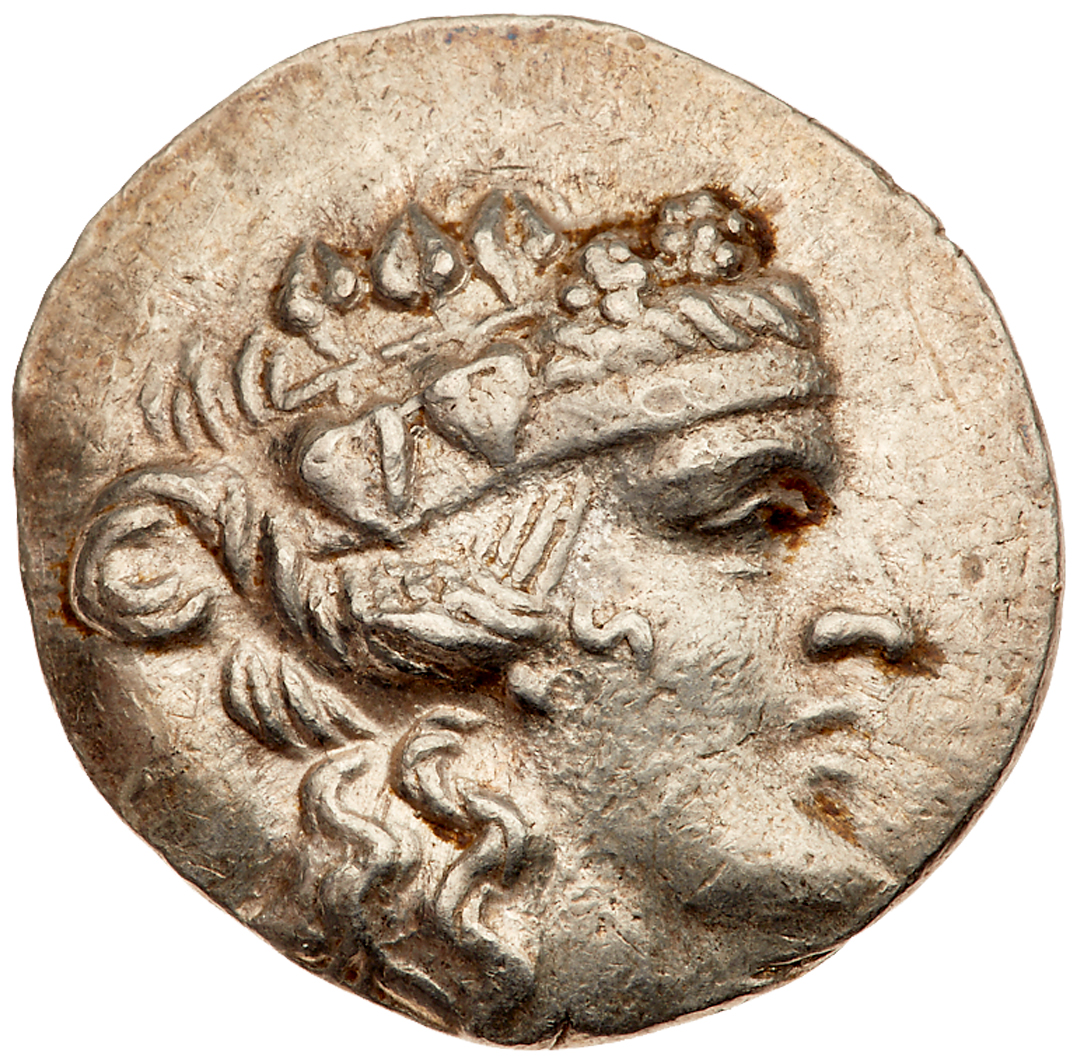 |
Eastern Europe, Imitating Thasos. Silver Tetradrachm (16.88 g), late 2nd-1st centuries BC. Wreathed head of Dionysos right. rev. HPAKΛEOYΣ ΣΩTHPOΣ ΘAΣIΩN, Herakles standing facing, head left, holding club and lion's skin; in inner left field, MH monogram. Kostial 956-8; OTA class I; CCCBM I 220-1. Lightly toned. Extremely Fine. Estimated Value $400
View details and enlarged photos
| Realized
$354 |
Lot 5 |
 |
Campania, Neapolis. Silver Nomos (7.39 g), ca. 320-300 BC. Head of nymph right; behind, Artemis advancing right, holding torch; before, AP monogram. rev. NEAΠOΛITΩN in exergue, man-headed bull standing right, head facing; above, Nike flying right, crowing bull with wreath; below, Π. SNG ANS 365; HN Italy 571. Lightly toned and excellent metal. Extremely Fine. Estimated Value $750
From the Dionysus Collection.
View details and enlarged photos
| Realized
$1,534 |
Lot 6 |
 |
Calabria, Taras. Silver Diobol (1.25 g), ca. 325-280 BC. Head of Herakles facing slightly left, wearing lion's skin headdress; club at shoulder. rev. Herakles standing right, wrestling the Nemean lion; in left field, club; between legs of Herakles, Φ. Vlasto 1348 (same dies); SNG ANS 1431; HN Italy 977. Perfectly centered and sharply struck obverse. Exceptional for the issue. A miniature numismatic gem! Toned. Extremely Fine. Estimated Value $1,000
Ex Hess-Divo 317 (27 October 2010), lot 10;
Ex Peus 372 (30 October 2002), lot 39;
Ex Peus 345 (1 November 1995), lot 19.
View details and enlarged photos
| Realized
$1,416 |
Lot 7 |
 |
Calabria, Taras. Silver Nomos (6.47 g), ca. 280-272 BC. Phy…, Sodamos and Gy…, magistrates. The Dioskouroi on horseback riding left; above, magistrate's monogram: ΦY; below, between horses' hooves, magistrate's name: [ΣΩΔ-A-M]-O-Σ. Rev: TA-[PAΣ], Taras seated astride dolphin left over waves, holding Nike crowning him with wreath and small, round shield ornamented with a hippocamp and javelins; in left field, magistrate's name: ΓY. Vlasto 773-80; HN Italy 1011. Boldly struck and very choice. Attractively toned. Removed from an NGC holder where graded AU, strike: 4/5, surface: 5/5. Our grade Superb Extremely Fine. Estimated Value $750
From the Dionysus Collection.
The city of Taras was named for the hero of the same name who was a son of Poseidon and the nymph Satyrion. He was shipwrecked during a crossing from Tainaron in the Peloponnesos to southern Italy, but Poseidon sent a dolphin to carry him to safety. The city was founded not far from the site where the hero came ashore. It has been suggested that this myth may reflect actual occurrences of dolphins saving shipwrecked sailors from drowning. This particular issue may have been struck to hire mercenaries to support Taras against the Romans during the Pyrrhic War (280-275 BC).
View details and enlarged photos
| Realized
$1,770 |
Lot 8 |
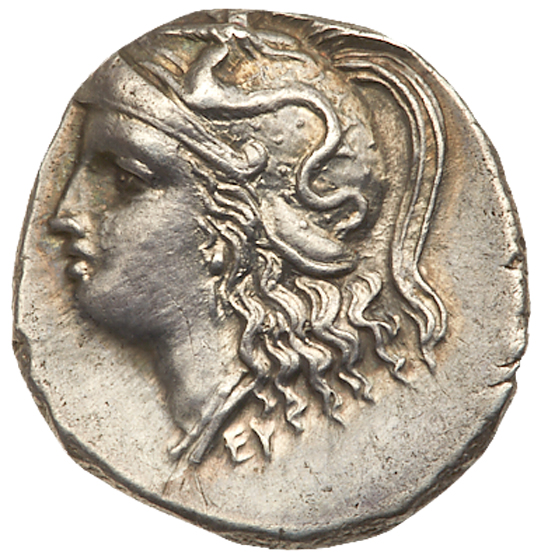 |
Calabria, Taras. Silver Drachm (3.29 g), ca. 280-272 BC. Helmeted head of Athena left; below, EY. rev. TAPANTINΩN, owl standing right on thunderbolt, head facing; in right field, ΣΩ. Vlasto 1077; SNG Delepierre 250; HN Italy 1018. Lustrous surfaces and lightly toned. Superb Extremely Fine. Estimated Value $300
From the Dionysus Collection.
View details and enlarged photos
| Realized
$649 |
Lot 9 |
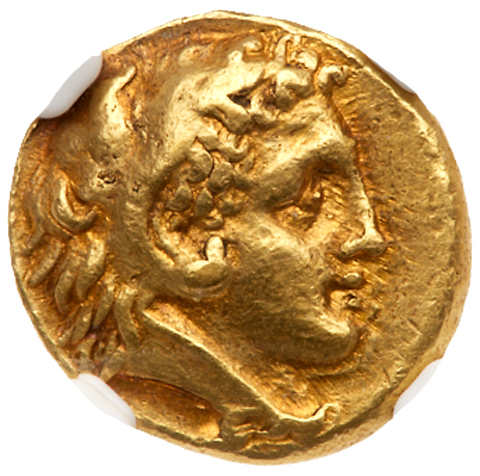 |
Calabria, Taras. Pyrrhos of Epiros. Gold Hemistater (4.28 g), ca. 276-272 BC. Head of Herakles right, wearing lion's skin headdress. rev. TAPANTINΩN, Taras (or Phalanthos?), holding reins and trident, driving galloping biga right; in upper right field, AP monogram; below horses' forelegs, NK monogram. Fischer-Bossert G30 (V26/R30); Vlasto 30 (same dies); SNG ANS 1037 (same dies); HN Italy 985. NGC grade XF; Strike: 5/5, Surface: 3/5. Fine style. Estimated Value $1,500
View details and enlarged photos
| Realized
$3,658 |
Lot 10 |
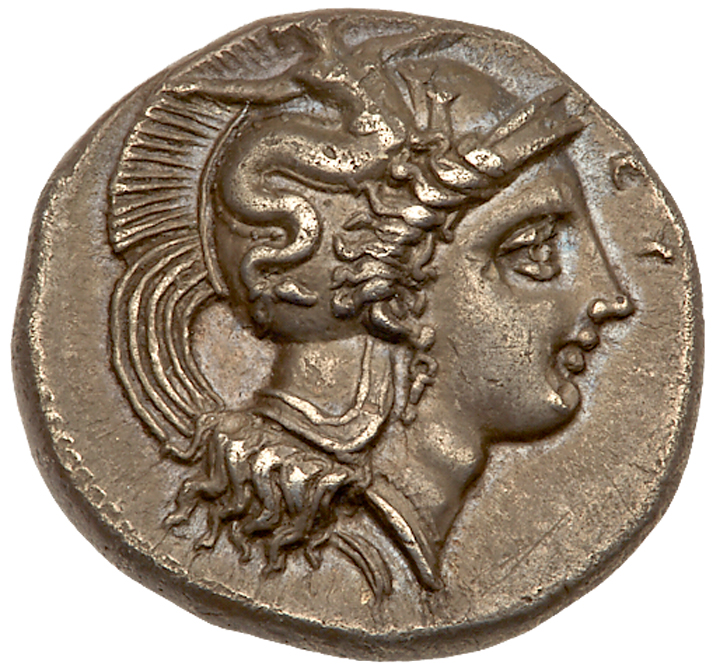 |
Lucania, Herakleia. Silver Nomos (7.74 g), ca. 390-340 BC. Head of Athena right, wearing crested Attic helmet decorated with Skylla throwing stone, single-pendant earring and necklace, before, EY. Rev: [|-HPAKΛ]-EIΩN, Herakles standing facing, leaning right, strangling the Nemean lion; behind, [AΠOΛ] and club; below, oinochoe. Van Keuren 51 (same obv. die as illus.); Work 47 (same dies); HN Italy 1378. A nice bold strike, excellent detail, and superbly toned. One of the finest to have come on the market in decades. Superb Extremely Fine. Estimated Value $3,500
From the Dionysus Collection.
Ex Gemini VII (9 January 2011), lot 30.
Herakleia in Lucania was a joint foundation of the Dorian Tarentines and the Ionian (Athenian) Thurians on the Gulf of Taranto in 432 BC. Although it rose to prominence primarily under the patronage of Taras, the city's dual origin was frequently advertised on the coinage of Herakleia. A head of Athena similar to that found on the coinage of Thourioi and alluding to that city's Athenian origins appears on the obverse while Herakles is depicted slaying the Nemean Lion on the reverse. The hero at once serves as a badge of the city bearing his name and as a symbol of the Dorian Greeks as a whole since all of the Dorians traced their ancestry back to the sons of Herakles.
View details and enlarged photos
| Realized
$6,490 |
Lot 11 |
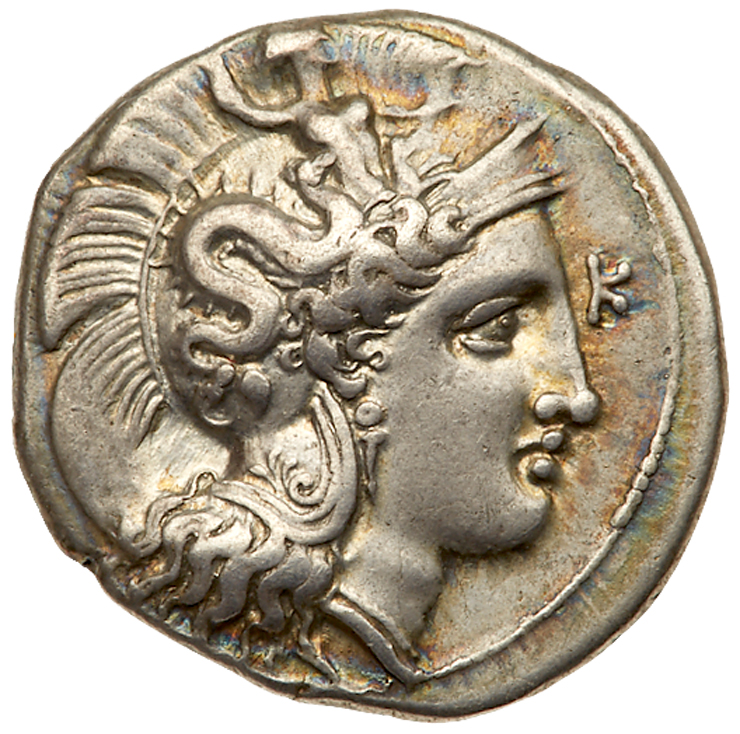 |
Lucania, Herakleia. Silver Nomos (7.84 g), ca. 335-300 BC. Head of Athena, wearing crested Attic helmet decorated with Skylla hurling stone; in right field, K. rev. [HPAKΛHITΩN] (faintly visible), Herakles standing facing, holding club, bow and lion's skin; above, Nike flying right crowning him with wreath. Van Kauren 80; SNG ANS 24; HN Italy 1383. Well struck and delicately toned. A beautiful example of fine style and execution. Extremely Fine. Estimated Value $1,000
From the Dionysus Collection.
View details and enlarged photos
| Realized
$2,124 |
Lot 12 |
 |
Lucania, Metapontion. Silver Nomos (7.81 g), ca. 330-290 BC. Wreathed head of Demeter left. rev. Barley ear with leaf to left; above leaf, tongs; below leaf, AΘA. Johnston class C, 4.8 (same dies); HN Italy 1583. Boldly struck and perfectly centered. All delicately toned. An outstanding example. Superb Extremely Fine. Estimated Value $2,500
From the Dionysus Collection.
Metapontion, located at an advantageous location in the instep of the "boot" of Italy, was founded early in the eighth century BC by Achaean colonists in an attempt to deny the site to the Dorians of Taras. The Metapontines grew wealthy from their rich grain-producing hinterland and thus a full grain ear became a common civic badge on coins of Metapontion already in the sixth century BC. This nomos illustrates the continuation of this tradition into the early Hellenistic period. This particular emission may have been struck in connection with the adventures of foreign dynasts in southern Italy. Metapontion was an ally of Alexander the Molossian during his campaigns against the Lucanians and Bruttians in 332-326 BC, but opposed Kleonymos of Sparta in 303 BC. This opposition cost the city dearly and the Metapontines were at last forced to pay exorbitant sums to Kleonymos and his Lucanian allies.
View details and enlarged photos
| Unsold |
Lot 13 |
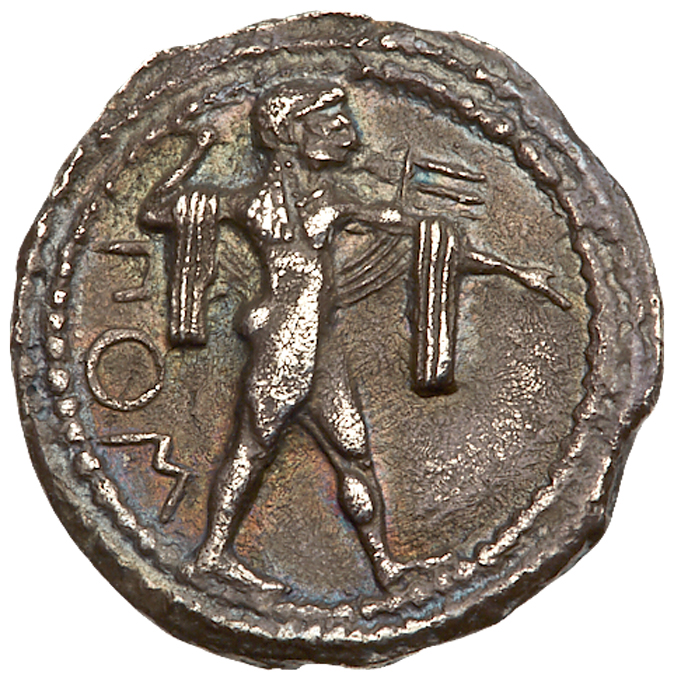 |
Lucania, Poseidonia. Silver Drachm (3.70 g), ca. 530-500 BC. ΠOM, Poseidon advancing right, preparing to hurl trident. rev. Incuse of obverse, but ΠOΣ (Σ facing downward) retrograde and in relief. Gorini 9; HN Italy 1108. Rare. Boldly struck and perfectly centered. Old cabinet tone. Seldom seen this choice. Extremely Fine. Estimated Value $3,500
From the Dionysus Collection.
Ex Dr. Murray Gell-Mann Collection
ex NAC 4 (27 February 1991), lot 16
ex Leu 2 (25 April 1972), lot 41.
View details and enlarged photos
| Realized
$5,900 |
Lot 14 |
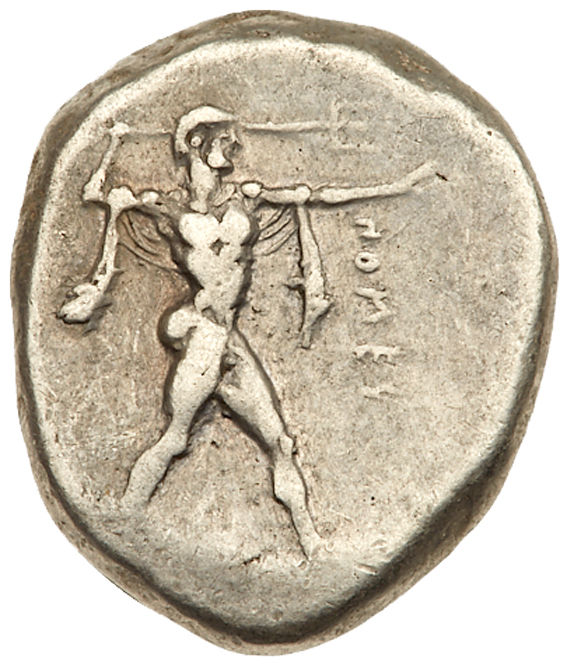 |
Lucania, Poseidonia. Silver Nomos (8.04 g), ca. 470-445 BC. ΠOMES, Poseidon advancing right, wielding trident; triple circular border. rev. ΠOMES, bull standing left within circular incuse. SNG ANS 651-3; HN Italy 1114. Lightly toned. Very Fine. Estimated Value $400
From the Dionysus Collection.
View details and enlarged photos
| Realized
$502 |
Lot 15 |
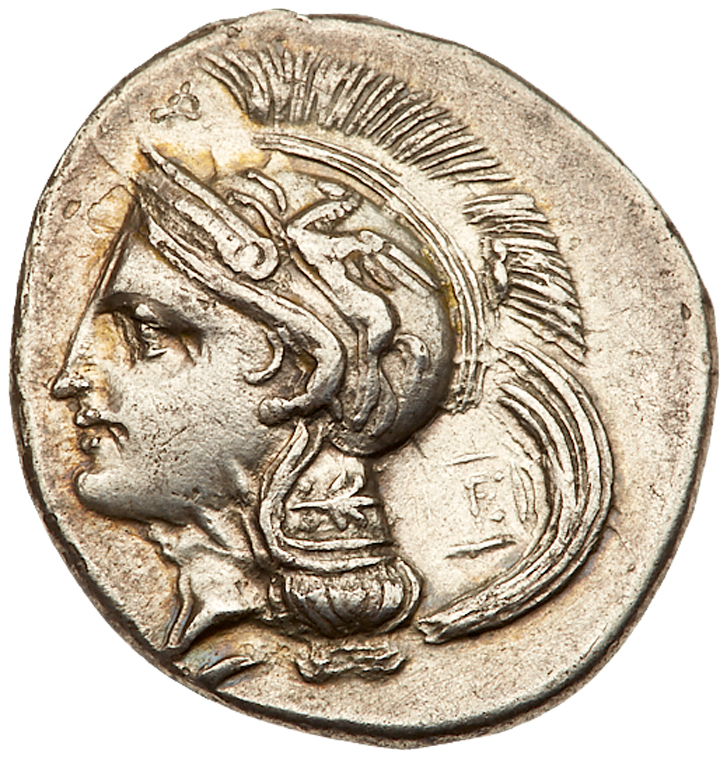 |
Lucania, Velia. Silver Nomos (7.44 g), ca. 300-280 BC. Head of Athena left, wearing crested Attic helmet decorated with a griffin; above visor, A; within shallow incuse square behind neck guard, IE. rev. YEΛH[TΩN], lion attacking stag left. Williams 561 (281/R394); SNG Ashmolean 1394 (same dies); SNG Lockett 571 (same dies); HN Italy 1318. Lightly toned. Extremely Fine. Estimated Value $1,000
From the Dionysus Collection.
View details and enlarged photos
| Unsold |
Lot 16 |
 |
Bruttium, The Bretti. Silver Drachm (4.76 g), 216-214 BC. Second Punic War issue. Diademed and draped bust of Nike right, wearing single-pendant earring and necklace. rev. BPETTIΩN, River god standing facing, crowning himself with wreath and holding scepter; in right field, rhyton. Arslan dies 35/53; HN Italy 1959. Well struck and nicely toned. Extremely Fine. Estimated Value $800
From the Dionysus Collection.
View details and enlarged photos
| Realized
$1,180 |
Lot 17 |
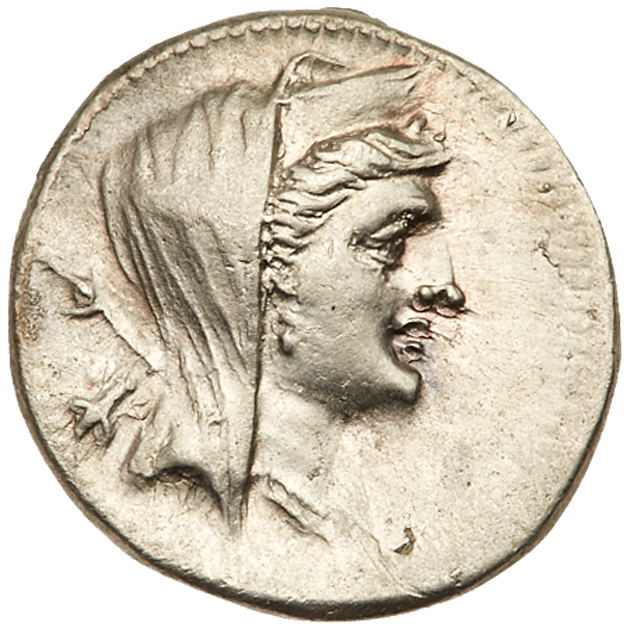 |
Bruttium, The Bretti. Silver Drachm (4.23 g), 216-214 BC. Second Punic War issue. Veiled head of Hera Lakinia right, wearing polos; over shoulder, scepter and fly. rev. BPETTIΩN, Zeus standing left, resting foot on Ionic capital, holding scepter; in left field, eagle flying left, holding wreath in talons. Arslan dies 29/43'; HN Italy 1970. Minor porosity, untoned. Extremely Fine. Estimated Value $500
From the Dionysus Collection.
View details and enlarged photos
| Realized
$826 |
Lot 18 |
 |
Bruttium, Kaulonia. Silver Nomos (7.63 g), ca. 500-480 BC. KAVΛO (retrograde), Apollo advancing right, holding branch; small daimon running right on Apollo's outstretched arm; to right, stag standing right, head turned back. rev. Incuse of obverse, but daimon and ethnic in relief and palm branch to right. Noe grp. D, 53 (same obv. die); HN Italy 2038. Rare. Underlying luster present. About Extremely Fine. Estimated Value $2,000
From the Dionysus Collection.
This issue of Kaulonia belongs to a remarkable class of coins struck by Greek cities in southern Italy in the late sixth century BC and characterized by incuse reverse designs replicating the raised designs of the obverse. The reason for the development of this peculiar and technologically complex method of coining (obverse and reverse dies needed to be produced with precision so that the raised and incuse designs would line up properly on the finished coin) remains unclear. It has been suggested, a little implausibly, that the incuse reverses were employed to facilitate the easy stacking of coins. Perhaps somewhat more likely are the suggestions that the incuse reverses might have been intended to thwart counterfeiting or that they represent the influence of local tradtions of repoussé work in Magna Graecia. Whatever the case, the coins are impressive in the technological skill required to create them and charming in their Archaic style.
View details and enlarged photos
| Realized
$2,360 |
Lot 19 |
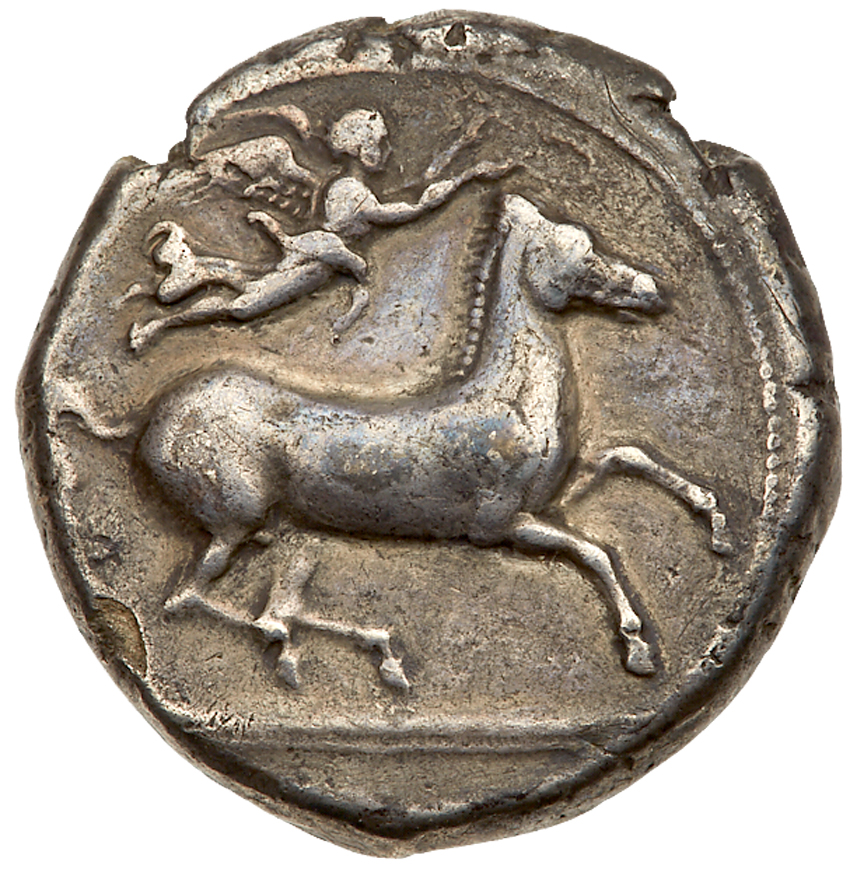 |
Sicily, Entella. Siculo-Punic mint. Silver Tetradrachm (17.12 g), ca. 410-392 BC. Horse prancing right on double exergual line; above, Nike flying right, crowning horse with wreath. rev. Palm tree with two bunches of dates. Jenkins 43 (O12/R38). HGC 2-266. Interesting die-break on reverse at 11 o'clock. Nicely toned. Choice Very Fine. Estimated Value $2,000
From the Dionysus Collection.
View details and enlarged photos
| Realized
$4,720 |
Lot 20 |
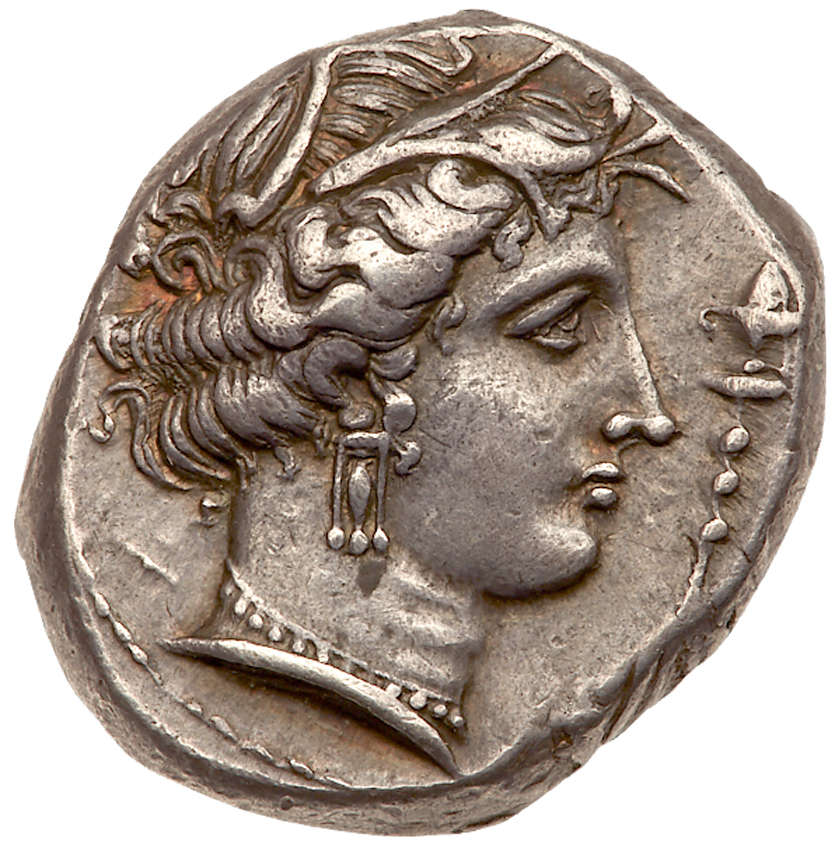 |
Sicily, Entella. Siculo-Punic mint. Silver Tetradrachm (16.95 g), ca. 350-300 BC. Head of Tanit-Persephone right, wreathed with grain leaves, wearing triple-pendant earring and necklace; before, thymiaterion. rev. Horse prancing right; in background, palm tree with two bunches of fruits; before, Nike flying left, crowing horse with wreath; below her, caduceus. Jenkins 96 (O33/R87); Jameson 910 (same obv. die); HGC 2-273. Attractively toned and of beautiful Punic style. Nearly Extremely Fine. Estimated Value $1,500
From the Dionysus Collection.
Ex Gemini III (9 January 2007), lot 80.
View details and enlarged photos
| Realized
$3,540 |
Lot 21 |
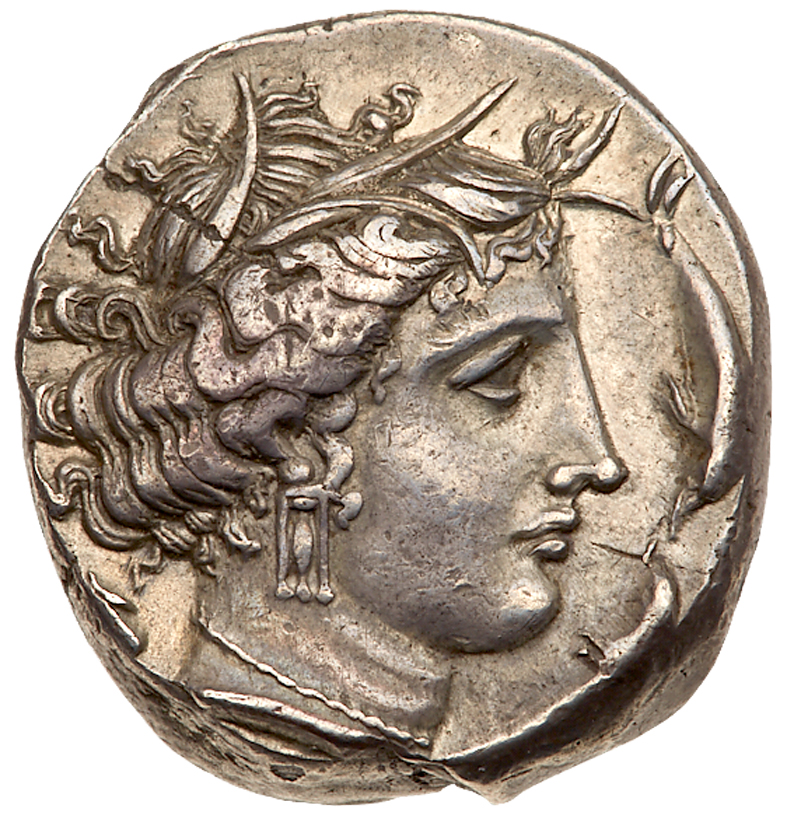 |
Sicily, Entella Siculo-Punic mint. Silver Tetradrachm (17.14 g), ca. 340-320 BC. Possibly Kephaloidion, Panormos, or a Carthaginian mobile mint. Head of Tanit right, wreathed with grain leaves, wearing triple-pendant earring and necklace; before, two dolphins opposed. rev. Horse standing right; in background, palm tree with two bunches of fruits. Jenkins 103 (O35/R93); HGC-2-275. Attractively toned and of lovely Punic style. Flan crack at 1 o'clock. We also note faint hairline scratches on the reverse. Extremely Fine. Estimated Value $2,000
From the Dionysus Collection.
Although Carthage had its own traditions in connection with horses, the horse reverse of this tetradrachm seems to be drawn from the "free horse" type brought from southern Italy to Sicily by Campanian mercenaries, many of whom sought Punic service against the Greek cities during the epic struggles for control of Sicily in the fifth and fourth centuries BC. It was an appropriate type for coins struck largely to pay Campanian and other mercenaries. The obverse type, on the other hand, imitates the popular Persephone type of Syracuse (ironically the chief opponent of Punic expansion into eastern Sicily). Here, however, the Greek grain goddess is reinterpreted as the Punic Tanit, the great goddess of Carthage.
View details and enlarged photos
| Realized
$3,540 |
Lot 22 |
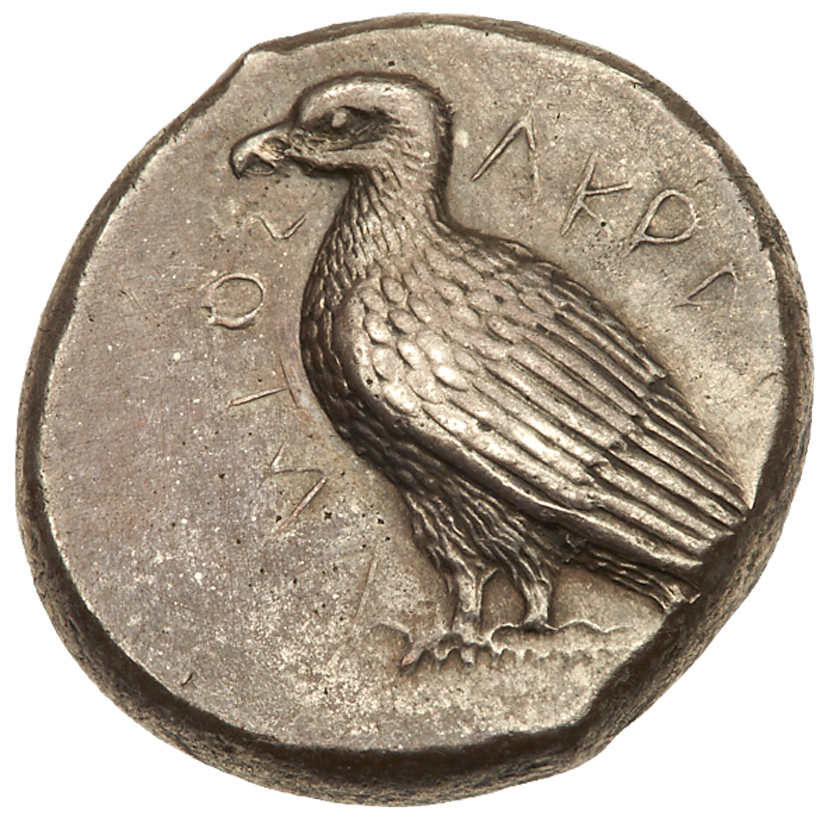 |
Sicily, Akragas. Silver Tetradrachm (17.39 g), ca. 465/4-446 BC. AKRAC-ANTOΣ (N and Σ retrograde), sea eagle with folded folded standing left. rev. Crab within circular incuse. Lee grp. I; Randazzo 12-4; SNG ANS 964-7 and 970-80. Boldly struck in high relief, well centered and Fine Style. Attractive, slightly iridescent, light greyish toning. Superb Extremely Fine. Estimated Value $5,000
From the Dionysus Collection.
The eagle and the crab were civic badges of Akragas and frequently appeared together or separately on the city's coinage from the fifth to the third century BC. The eagle is somewhat Archaic in style, but with detailed feathering, whereas the crab almost seems to be engraved from life. Every detail from the contours of the shell down to the serrated edges of the claws is present here, making this piece a real prize for the rare lover of both coins and marine biology.
View details and enlarged photos
| Realized
$8,850 |
Lot 23 |
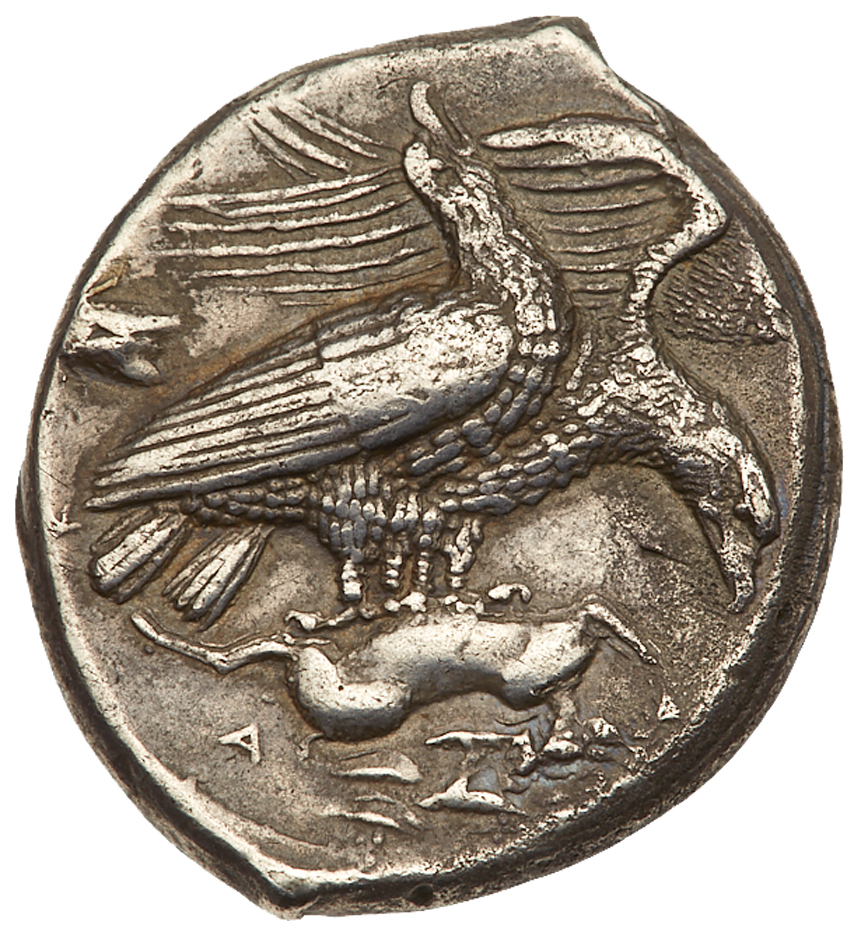 |
Sicily, Akragas. Silver Tetradrachm (17.11 g), ca. 409-406 BC. Nike, holding kentron and reins, driving galloping quadriga right; above, Nike flying left, crowning Nike with wreath; in exergue, ketos right. rev. A[KPAΓANTINON], two eagles standing left on dead hare, the closest eagle with wings closed and head raised, the further eagle with wings spread and head lowered; in left field, cicada. HGC-2-84; Seltman, NC (1948), 1 (three examples cited); SNG Copenhagen 24. Extremely Rare. Fine style and well struck in high relief. Light grey toning, very slight area of porosity. About Extremely Fine. Estimated Value $20,000
From the Dionysus Collection.
Ex Gorny & Mosch 138 (7 March 2005), lot 94
ex MMAG 61 (1982), lot 34.
The reverse depicting two eagles over the body of a hare is perhaps one of the most iconic types in the Akragantine series. The type is executed with great skill, illustrating the great birds with their prey. In the background one eagle spreads his wings and leans forward to be the first to peck at the carcass while the eagle in the foreground throws its head back as if screaming in triumph. The animated quality of the scene and the emotion it conveys is so remarkable that one can almost imagine the engraver witnessing the scene in life before committing it to the die for all time.
View details and enlarged photos
| Realized
$73,160 |
Lot 24 |
 |
Sicily, Entella. Silver Tetradrachm (16.97 g), ca. 300-289 BC. Head of Herakles right, wearing lion's skin headdress. rev. Horse's head right; behind, palm tree. Jenkins 317 (O101/R261); SNG Lloyd 1642; Basel 564; de Luynes 1449. Boldly struck with luster still present. A superb example. Nearly Mint State. Estimated Value $1,500
From the Dionysus Collection.
The Punic inscription on this coin names "the People of the Camp" and leaves no doubt about its use to pay the numerous foreign (primarily Italic) mercenaries that swelled the armies of Carthage during its conflict with the Greek cities for dominance on Sicily. "People of the Camp" issues are usually attributed to Entella, a frequent stronghold of Campanian mercenaries in the fourth and third centuries BC. The obverse of the coin features a depiction of Herakles drawn from the popular tetradrachms of Alexnder the Great - a type widely accepted by foreign mercenaries throughout the Mediterranean world - while the reverse features the head of a horse and a palm tree. The palm tree (phoinix in greek) alludes to the Phoenician origin of the Punic peoples of North Africa while the horse refers to the somewhat bizarre tradition that Carthage was founded by the Tyrian queen Dido on a hill where the head of a horse was unearthed.
View details and enlarged photos
| Realized
$1,770 |
Lot 25 |
 |
Sicily, Gela. Silver Tetradrachm (17.30 g), ca. 480-475 BC. Charioteer driving slow quadriga right; above, Nike flying right, crowning horses with wreath. rev. C-E-Λ-AΣ, forepart of man-headed bull to right. Jenkins grp. II, 104 (O32/R59); Randazzo 19 (same dies); SNG ANS 22 (same dies); SNG Ashmolean 1727 (same dies); SNG Copenhagen 251 (same dies); Jameson 580 (same dies). Well struck and free from the porosity that usually accompanies this popular issue. Delicately toned. Choice Very Fine. Estimated Value $2,500
From the Dionysus Collection.
Ex Roma E3 (30 November 2013), lot 49.
Found by colonists from Rhodes and Crete in 688 BC, Gela was located on the south-eastern coastal plain of Sicily along the banks of the river Gela, from which it reaped a fertile soil and bountiful harvests. By the early fifth century, the wealth generated from its hinterland allowed the city's early tyrants to expand militarily at the expense of its neighbors, and Gela soon dominated several cities, amongst them Leontinoi, Naxos, Zankle-Messana and Syracuse. The tyrant Gelon, after conquering Syracuse, moved there, leaving his brother Hieron I in charge of Gela. After Gelon's death in 478 BC, Hieron took control of Syracuse and left the city of Gela to Polyzelos. Little is known of Polyzelos, but it was during his tyranny that the city began striking tetradrachms, replacing the earlier didrachms that had been the principal denomination in use at Gela. The charioteer on the obverse is copied from Syracuse, but shows the Charioteer of Delphi, one of the most well-known bronze statues from antiquity and which Polyzelos dedicated to Apollo of Delphi in order to celebrate the victory of his chariot in the Pythian Games of either 478 or 474. The reverse reuses the type from the city's didrachm coinage, and depicts the forepart of the river-god Gelas. The immediate impression when first looking at this particular coin is that the detail is exceptional, and that the dies were engraved by a truly skilled artist. Indeed, the dies used to strike this coin are the first of the series, so it stands to reason that the artist was perhaps contracted by Polyzalos himself, who sought out the finest masters in order to commemorate both his rule over his city and his Pythian victory with a new denomination.
View details and enlarged photos
| Realized
$4,248 |
Lot 26 |
 |
Sicily, Himera. Silver Tetradrachm (17.52 g), ca. 409-407 BC. Signed by the artist Mai… maestro della foglia ("Master of the leaf"). Charioteer, holding reins in both hands, driving fast quadriga right; above, Nike flying left, crowning charioteer with wreath and holding tablet inscribed MAI; in exergue, ketos left. rev. [I]MERION (retrograde), Himera standing facing, head left, sacrificing out of patera over horned altar and raising arm; to right, satyr bathing in fountain beneath lion-headed spout. Gutmann-Schwabacher 20; Arnold-Biucchi 22; Rizzo pl. 21, 23; Basel 306; Kraay-Hirmer 71. Lustrous and lightly toned. Mint State. Estimated Value $8,000
From the Dionysus Collection.
This tetradrachm belongs to the celebrated Sicilian tradition of coin dies signed by their highly skilled engravers. The MAI who signed this issue also signed dies that he engraved for Syracuse. So-called maestro della foglia because of the high classical artistry of the artist's dies and his penchant for "signing" them with an olive leaf. The coin was produced at the same time that the engravers of Syracuse were signing their dies with their names and reflects the same milieu of justified pride in the production of miniature masterpieces. Like other contemporary engravers, the maestro della foglia did not limit his work to the coinage of a single city. In addition to issues to issues of Katane, he also appears to have engraved dies for the coinage of Piakos.
Despite the high artistry of the coin, it was struck on the eve of disaster for Himera. In 410 BC, a Carthaginian expeditionary force under Hannibal Mago intervened in a conflict between Segesta and Selinous which resulted in the defeat of the latter and the destruction of Selinous in 409 BC. Although not part of his mandate, Mago followed this victory by besieging and destroying Himera in revenge for the defeat of his grandfather by the Himerites some 60 years earlier. This tetradrachm may have been hopelessly struck in part to hire mercenaries and improve the poor fortifications of Himera in response to the threat of the Carthaginian army.
View details and enlarged photos
| Unsold |
Lot 27 |
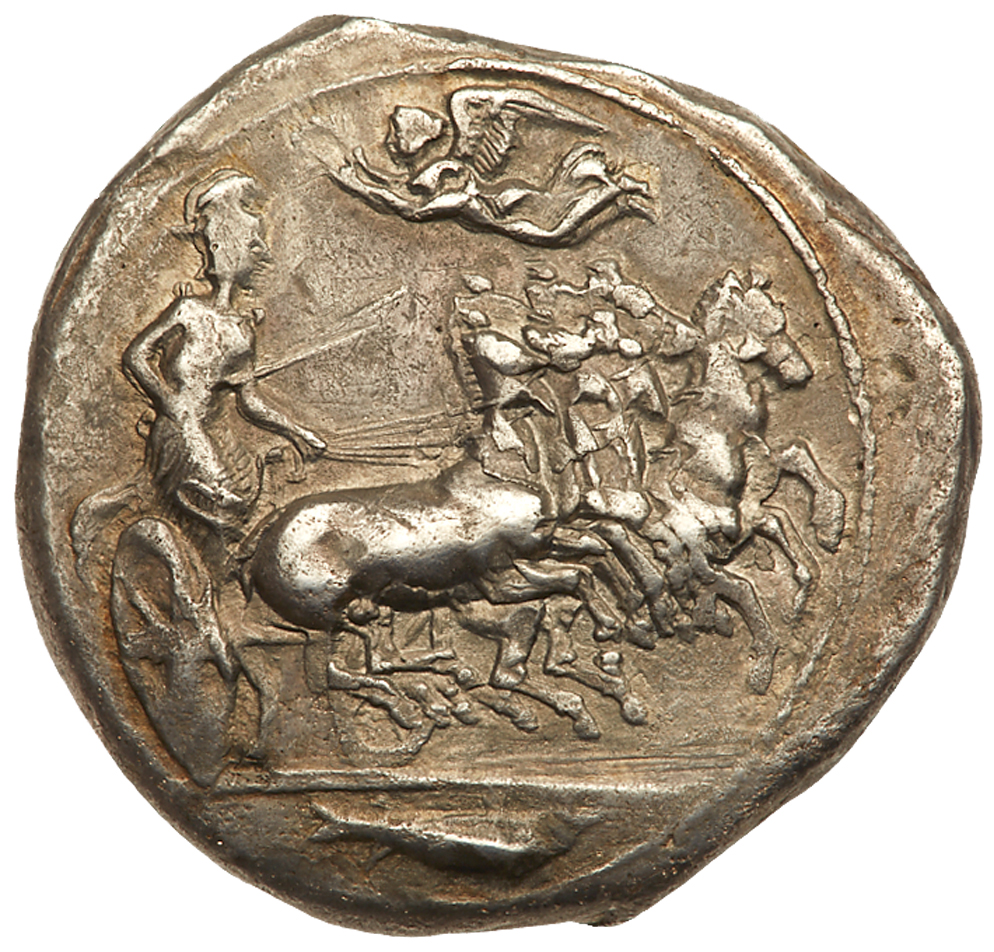 |
Sicily, Kamarina. Silver Tetradrachm (16.96 g), ca. 425-405 BC. Athena driving galloping quadriga right; above, Nike flying left, crowning Athena with wreath; in exergue, fish right.rev. KAMAPI-NAION, bearded head of Herakles left, wearing lion's skin headdress. Westermark & Jenkins 144 (O6/R12); SNG Lloyd 869 (same dies); Rizzo pl. 5, 14 (same dies); BMFA 259 = Warren 206 (same dies). Minor flan defect on nose and jaw. Lightly toned. Choice Very Fine. Estimated Value $3,000
From the Dionysus Collection.
Founded by the Syracusan oikists Daskon and Menekolos in 598 BC, the city of Kamarina sat on the southeastern corner of Sicily, closer to Gela than to its parent city. Both cities vied for influence, with the result that Kamarina was sacked and resettled numerous times throughout its turbulent history. During the Athenian Expedition on the late fifth century BC, Kamarina remained officially neutral but grudgingly lent limited support to defend Syracuse. It was at this time that the city's mint began producing this remarkable series of tetradrachms, initially copying the quadriga type of Syracuse in a somewhat stilted fashion, then following it with tetradrachms of much superior style vividly depicting a racing quadriga combined with a wonderful portrait of Herakles. The minting of these beautiful coins lasted only until 405 BC, as the mint ceased operations when the city's inhabitants were evacuated to Syracuse due to Carthaginian activity in the area.
View details and enlarged photos
| Realized
$4,956 |
Lot 28 |
 |
Sicily, Katane. Silver Tetradrachm (16.98 g), ca. 435-425 BC. Dies by the "Maestro della foglia". Charioteer, holding kentron and reins, driving fast quadriga right; above, Nike flying right, crowning horses with wreath.rev. KATANAION, laureate head of Apollo right; behind, plane-leaf (mostly off flan). SNG Lloyd 898 (same dies); SNG ANS 1256 (same dies); Rizzo pl. 11, 16 (these dies); Gulbenkian 185 (these dies). Beautiful fine classical style. Slightly short of flan, delicate light toning. Extremely Fine. Estimated Value $3,000
From the Dionysus Collection.
View details and enlarged photos
| Unsold |
Lot 29 |
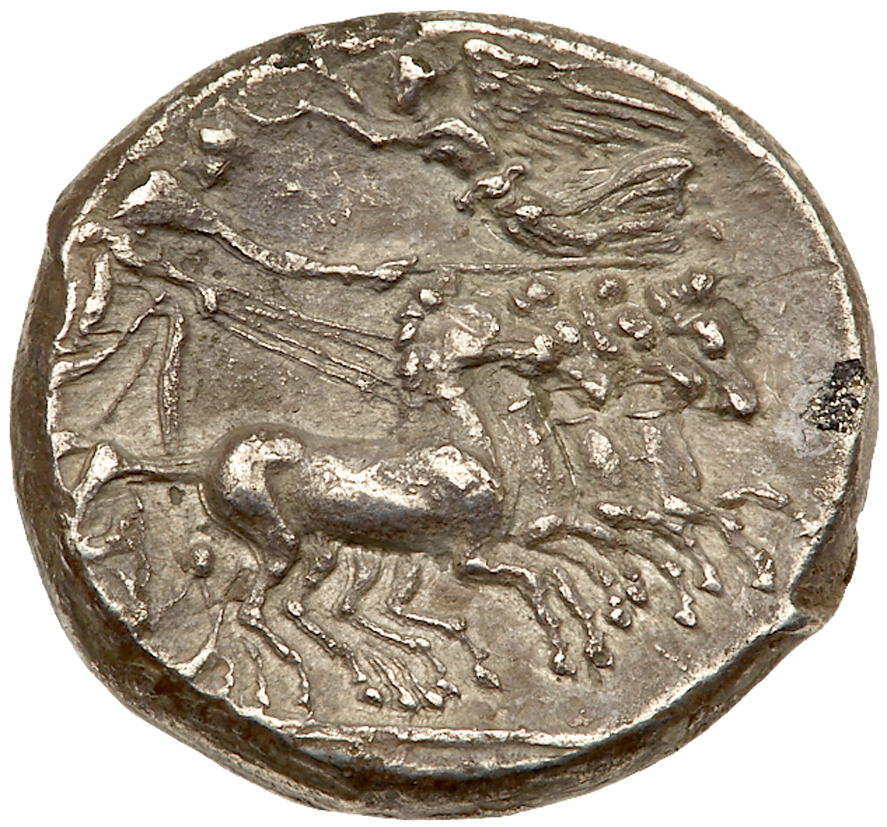 |
Sicily, Lilybaion. Silver Tetradrachm (16.46 g), ca. 325-305 BC. Charioteer, holding kentron and reins, driving galloping quadriga right; above, Nike flying left, crowning charioteer with wreath. rev. Head of Arethusa left, wreathed with grain ears, wearing triple-pendant earring and necklace; around, three dolphins. Jenkins 39 (O14/R30); SNG Lloyd 1605 (same dies); de Luynes 921 (same dies). Lightly toned. Choice Very Fine. Estimated Value $2,000
From the Dionysus Collection.
View details and enlarged photos
| Unsold |
Lot 30 |
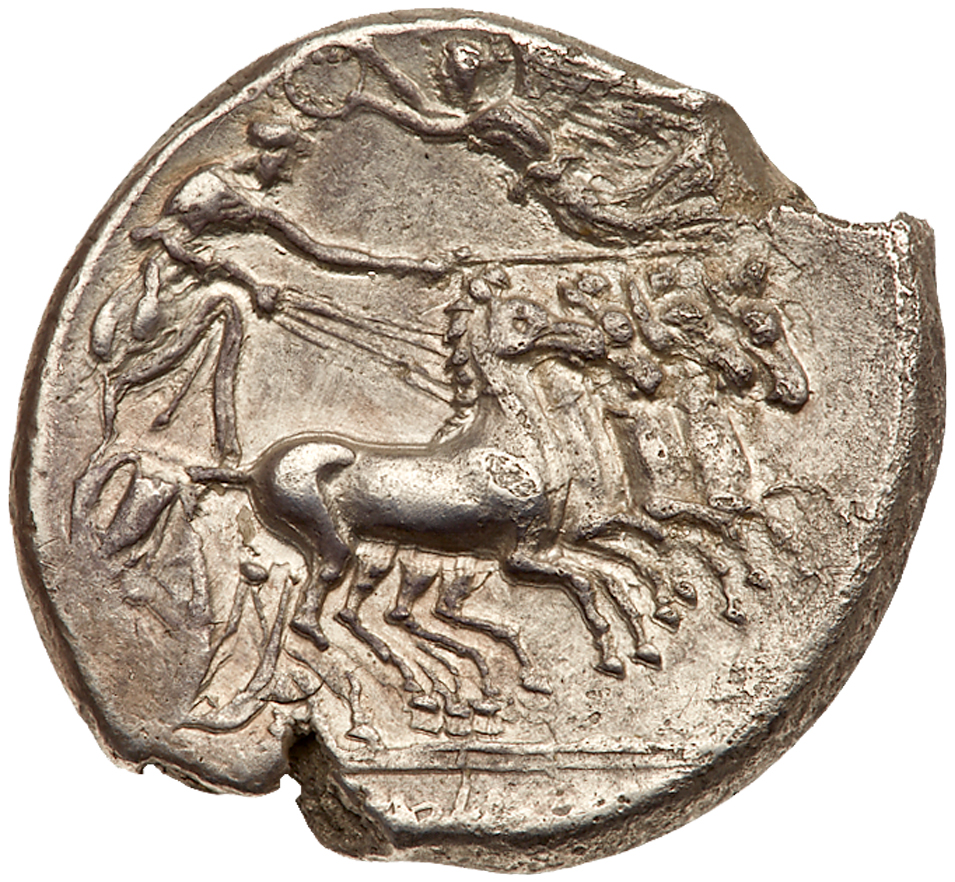 |
Sicily, Lilybaion. Silver Tetradrachm (16.89 g), ca. 325-305 BC. Charioteer, holding kentron and reins, driving galloping quadriga right; above, Nike flying left, crowning charioteer with wreath.rev. Head of Arethusa left, wreathed with grain ears, wearing triple-pendant earring and necklace; around, three dolphins. Jenkins 37 (O14/R28); Jameson 957 (same dies); de Luynes 920 (same dies). Well struck and well centered on a wide, slightly irregular flan. Lightly toned. Superb Extremely Fine. Estimated Value $1,500
From the Dionysus Collection.
View details and enlarged photos
| Unsold |
Lot 31 |
 |
Sicily, Messana. Silver Tetradrachm (16.88 g), ca. 478-476 BC. Charioteer, holding kentron and reins, driving slow biga of mules right; in exergue, olive leaf. rev. MESS-ENIO-N (retrograde), hare springing right. Caltabiano 48 (D24/R26); Randazzo 91-2 (same dies); SNG ANS 10 (same dies). Toned. Nearly Extremely Fine. Estimated Value $1,000
From the Dionysus Collection.
View details and enlarged photos
| Realized
$1,652 |
Lot 32 |
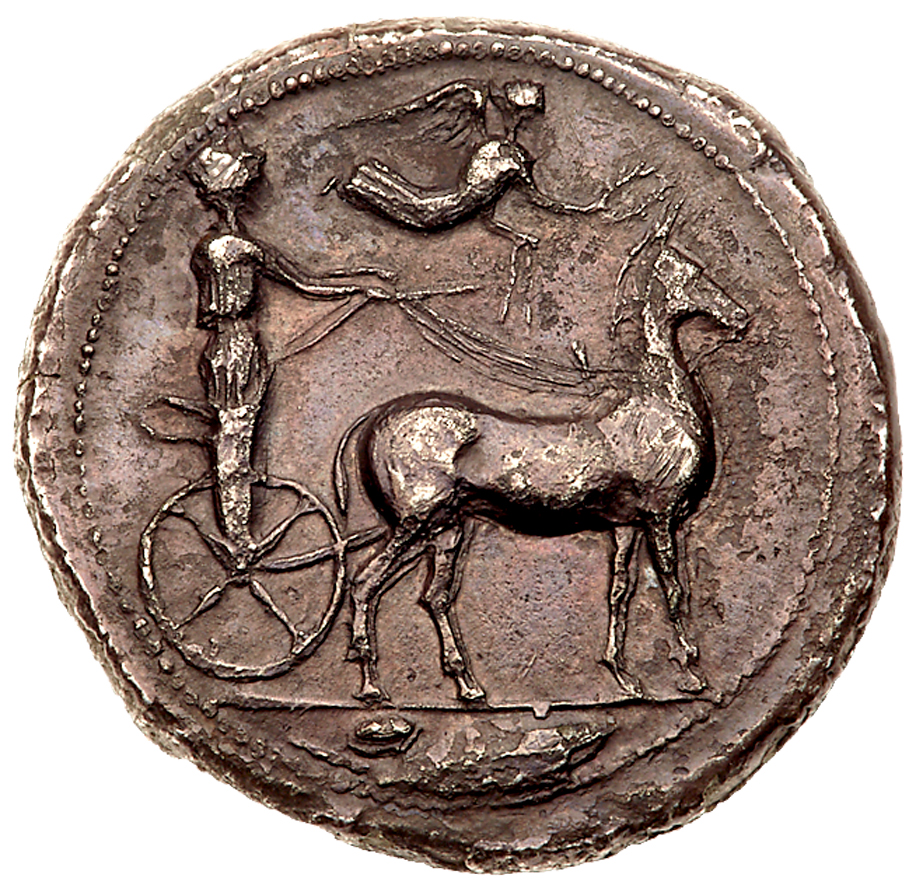 |
Sicily, Messana. Silver Tetradrachm (16.02 g), 425-421 BC. Charioteer, holding kentron and reins, driving biga of bules left; above, Nike flying right, crowning charioteer with wreath, and holding fillet. rev. MEΣΣANION, hare springing right; below, hippocamp left. Caltabiano series XIII, 494 (D201/R202); SNG Lloyd 1094 (same dies). Well struck on a slightly porous flan. Well toned. Choice Very Fine. Estimated Value $1,000
View details and enlarged photos
| Realized
$1,534 |
Lot 33 |
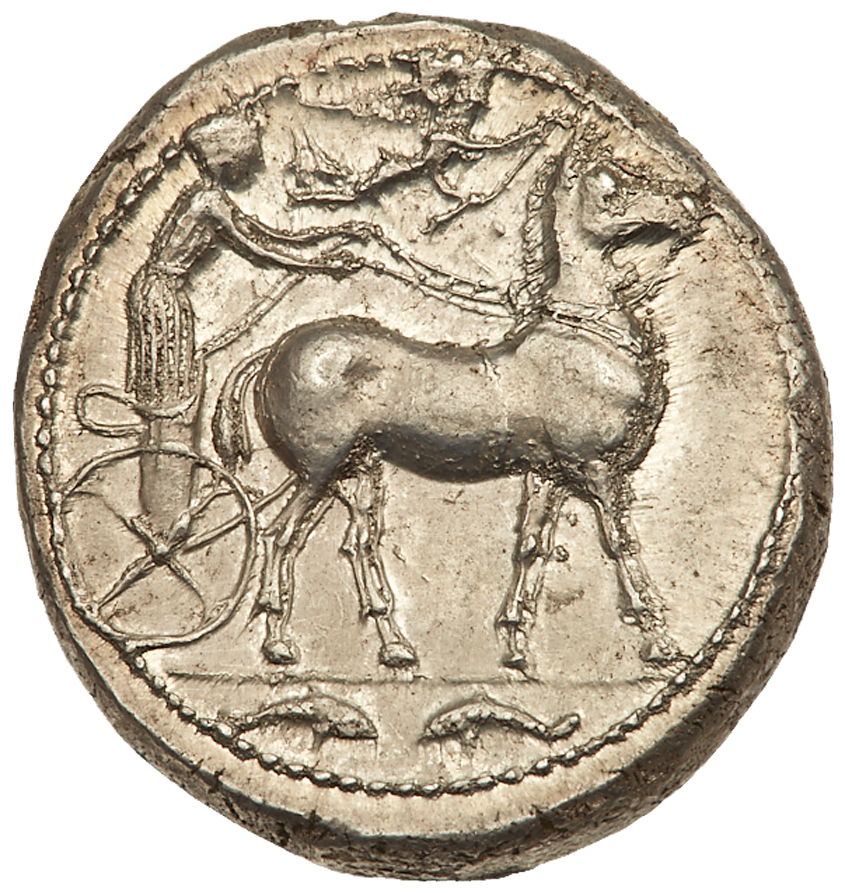 |
Sicily, Messana. Silver Tetradrachm (17.44 g), ca. 420-413 BC. The nymph Messana, holding kentron and reins, driving slow biga of mules right; above, Nike flying right, crowning mules with diadem; in exergue, two dolphins confronted. rev. MEΣ-Σ-ANI-O-N, hare springing right; below, dolphin right. Caltabiano 499 (D202'/R207); SNG ANS 361 (same dies); SNG Lockett 826 (same obv. die). Well struck and from finely executed dies. Lustrous surfaces with a tiny area of horn silver at 6 o'clock on the reverse. Beautiful fresh dies. Nearly Mint State. Estimated Value $3,000
From the Dionysus Collection.
The mule biga and leaping hare types of this coin reflect the strong political and iconographic influence of Rhegion across the strait in southern Magna Graecia in the fifth century BC. Both types were originally introduced by Anaxilas, the tyrant of Rhegion (494-476 BC), around 480 BC. The mule biga celebrated his victory in the Olympic Games in 484 or 480 BC while the hare supposedly referred to his importation of the animal to Sicily for hunting. Notably, while these types disappeared from the coinage of Rhegion after the death of Anaxilas, the hare became a civic badge of Messana that continued in use into the late fifth century BC. This coin illustrates the early transformation of the Rhegian types into civic types appropriate to Messana for here the local nymph rather than the tyrant drives the biga.
View details and enlarged photos
| Realized
$3,894 |
Lot 34 |
 |
Sicily, Messana. Silver Tetradrachm (16.93 g), ca. 412-408 BC. The nymph Messana driving biga of mules left; above, Nike flying right, crowning Messana with wreath; in exergue, two opposed dolphins.rev. MEΣ-Σ-A-NIO-N, hare springing right; below, youthful head of Pan right. Caltabiano 604 (D217/R235, this coin); SNG ANS 369 (same dies). Very Rare. A magnificent, bold and well detailed example. Attractively toned. Superb Extremely Fine. Estimated Value $5,000
From the Dionysus Collection
Ex Nomos 5 (25 October 2011), lot 118.
On this later tetradrachm, the Archaic style that characterizes the preceding lot has been thrown off and now Messana in the mule-biga and the leaping hare are treated in a fully classical style. No longer does Messana stand rigidly in her peplos, but now she is somewhat more naturalistic and her garment flows. Likewise, whereas the mules of the earlier tetradrachm stand with stiff legs all moving in parallel, on the present piece the animals are fully distinguished from one another by slight differences in view and pose.
View details and enlarged photos
| Realized
$8,850 |
Lot 35 |
 |
Sicily, Messana. The Mamertinoi. Æ Quincunx (14.30 g), 264-241 BC. Laureate head of Zeus right. rev. MAME[PTINΩN], warrior advancing left, holding forth shield on arm, and spear; in upper left field, four pellets. Särström series XVIII A; BAR 14; CNS 45. Attractive dark greenish-brown patina. Some minor porosity on reverse. Choice Very Fine. Estimated Value $300
From the Dionysus Collection.
View details and enlarged photos
| Realized
$561 |
Lot 36 |
 |
Sicily, Morgantina. The Sikeliotes. Silver 8 Litrai (6.78 g), ca. 214/3-213/2 BC. Veiled head of Persephone left, wreathed grain ears; behind, leaf. rev. ΣIKEΛIΩTAN, Nike, holding kentron and reins, driving galloping quadriga right; above, monogram. Sjöqvist 2; Enna 110; SNG ANS 1168. Slightly double-struck from finely detailed dies. Beautifully toned. Superb Extremely Fine. Estimated Value $3,000
From the Dionysus Collection.
Ex Hess-Divo 307 (2007), lot 1101
ex P. Arnaud Collection (MMAG List 496 (1987), lot 2.
In 263 BC, Morgantina was included in the Sicilian kingdom granted by the Romans to Hieron II of Syracuse, but the city chafed under Syracusan rule and the Roman garrison installed at the outbreak of the Second Punic War (218-201 BC). When the Morgantinans betrayed their city to Himilco, a Carthaginian commander, in 214 BC, Morgantina became a center for rallying the Greek cities of Sicily against Rome. As a means of promoting alliance with Carthage against Rome, a rare gold and silver coinage in the name of the Sikileotes, i.e. the united Greek Sicilians was struck - a little ironic since most attempts at unifying the Greek cities in Sicily since the early fifth century hinged on resisting the advance of Carthage. The types imitate those used for Syracusan coins struck in the name of Hieron's wife, Queen Philistis.
View details and enlarged photos
| Realized
$4,720 |
Lot 37 |
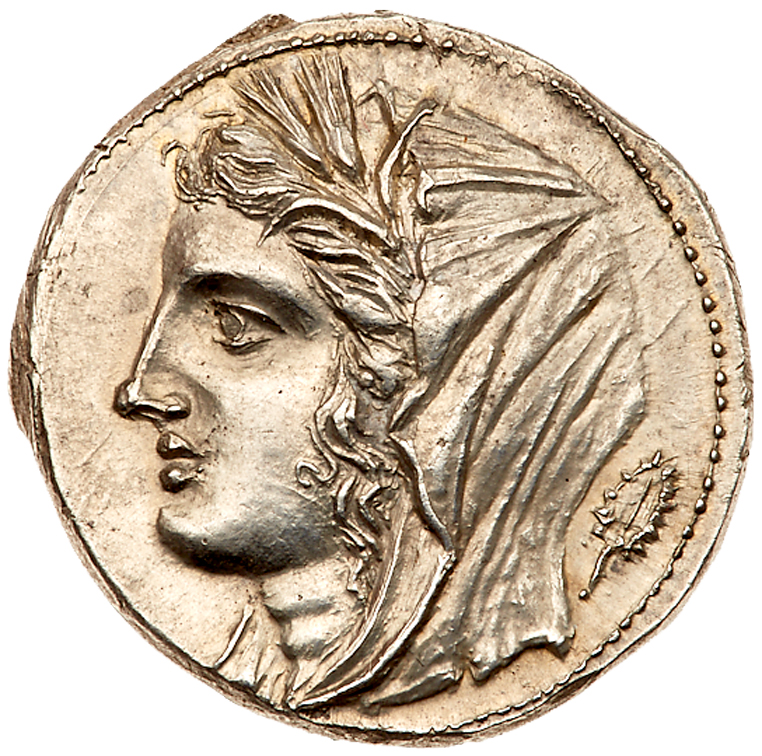 |
Sicily, Morgantina. The Sikeliotes. Silver 8 Litrai (6.90 g), ca. 214/3-213/2 BC. Veiled head of Persephone left, wreathed grain ears; behind, leaf. rev. ΣIKEΛIΩTAN, Nike, holding kentron and reins, driving galloping biga left; above, monogram. Sjöqvist 2; Enna 110; SNG ANS 1168. Well struck and lustrous. Nearly Mint State. Estimated Value $2,500
View details and enlarged photos
| Realized
$5,192 |
Lot 38 |
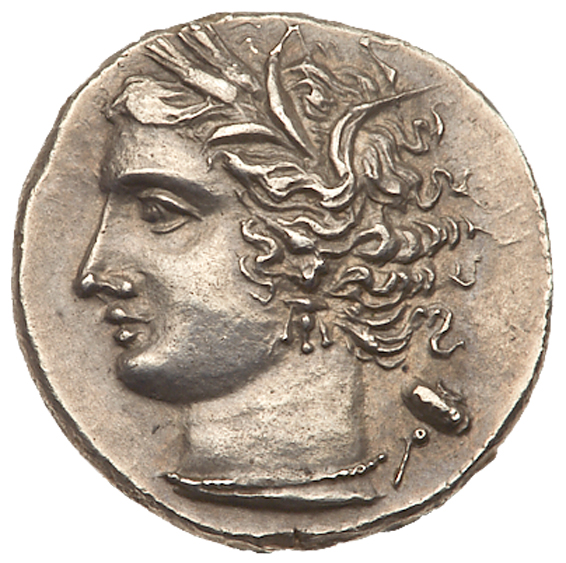 |
Sicily, Morgantina. The Sikeliotes. Silver 4 Litrai (3.95 g), ca. 214/3-213/2 BC. Veiled head of Persephone left, wreathed grain ears; behind, poppy. rev. ΣIKEΛIΩTAN, Nike, holding kentron and reins, driving galloping biga left; above, monogram. Sjöqvist 3; Enna 112 (same dies); Basel 415 (same dies). Rare. Lightly toned and absolutely superb. Nearly Mint State. Estimated Value $1,000
From the Dionysus Collection.
As on the preceding issue naming the Greeks of Sicily - the Sikeliotes - the Persephone and biga types are also derived from the earlier coinage of Hieron II. This time the model was provided by his important gold series, but the treatment of the goddess also suggests a relationship to the similar Tanit type used for coins of Carthage in the fourth and third centuries BC.
View details and enlarged photos
| Realized
$2,714 |
Lot 39 |
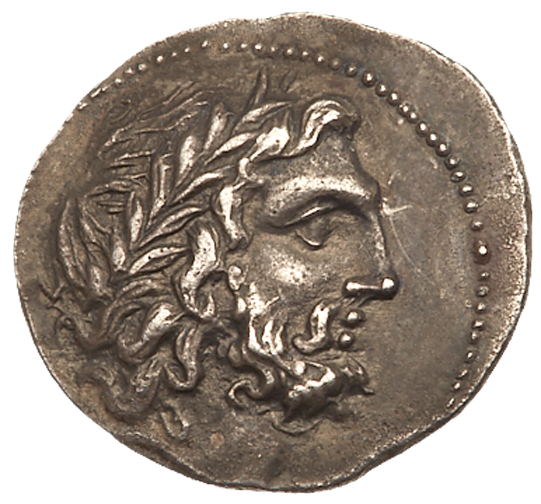 |
Sicily, Morgantina. The Sikeliotes. Silver 2 Litrai (1.84 g), ca. 214/3-213/2 BC. Laureate head of Zeus right. rev. ΣIKEΛIΩTAN, Soldier on horseback galloping right, holding couched spear; above, monogram. Enna -; SNG ANS 1169; Basel 416. Extremely Rare. Lovely old cabinet tone. Superb Extremely Fine. Estimated Value $750
From the Dionysus Collection.
Ex NAC L (18 May 2001), lot 1261
ex Auctiones 12 (29 September 1981), lot 57.
View details and enlarged photos
| Realized
$1,416 |
Lot 40 |
 |
Sicily, Naxos. Silver Drachm (4.17 g), ca. 460-430 BC. Bearded head of Dionysos right. rev. N-A-XI-ON, Silenos, nude, squatting half-left, holding kantharos before face. Chan 56 (V41/R47); SNG Lloyd 1152 (same dies); Jameson 676 (same dies); Pozzi 507 (same dies); de Luynes 1064 (same dies); BMC 9 (same dies). Extremely Rare. Nicely toned with touches of iridescence. A beautiful example of this iconic issue, Fine Style. Extremely Fine. Estimated Value $3,000
From the Dionysus Collection.
Naxos was the oldest Greek city to be established in Sicily, founded in 735 BC, the year before Syracuse by a body of Ionian colonists apparently involving an important contingent from the Cycladic island of Naxos. It is generally presumed that the Sicilian city gained its name from the Naxian origin of some of its colonists. The city flourished from the start and soon established its own colony at Leontinoi, but fell on hard times in the early fifth century BC, when Naxos was captured and fell successively under the domination of the tyrants of Gela and Syracuse. In 476 BC, Hieron of Syracuse forcibly removed the Naxians from their city and resettled it with new colonists as a means of breaking up power blocks that might have threatened his tyranny. The present drachm was struck after the end of the Deinomenid tyrany at Syracuse and the return of the exiled Naxians to their home in 461 BC. It features a somewhat Arachaic-looking head of Dionysos, but the three-quarter facing Silenos of the reverse is quite daring in its execution.
View details and enlarged photos
| Realized
$9,204 |
Lot 41 |
 |
Sicily, Panormos (as Ziz). Silver Tetradrachm (17.14 g), ca. 405-380 BC. Charioteer, holding kentron and reins, driving galloping quadriga left; above, Nike flying right, crowning charioteer with wreath. rev. Head of nymph left, wearing triple-pendant earring and necklace; around, three dolphins. Jenkins 52 (O14/R41). Rare. Excellent metal and toned. Very Fine. Estimated Value $1,000
From the Dionysus Collection.
View details and enlarged photos
| Realized
$1,652 |
Lot 42 |
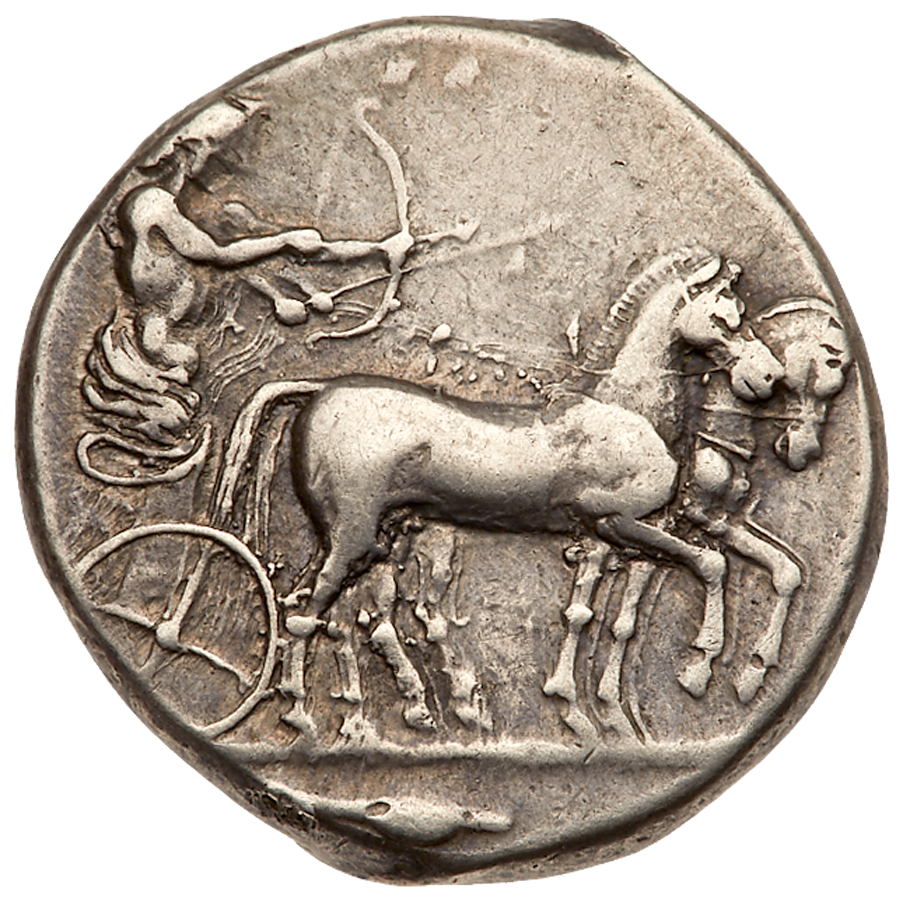 |
Sicily, Selinos. Silver Tetradrachm (17.04 g), ca. 440-430 BC. ΣEΛ-IN-[ONTION], Artemis, holding reins, driving quadriga right; beside her, Apollo standing, drawing bow; in exergue, grain ear. rev. Σ-EΛ-INONTI-ON, Selinos standing left, holding phiale over altar and laurel branch; on base of altar, rooster standing left; behind, selinon leaf above bull standing left on basis. Schwabacher 26; SNG ANS 700 (same dies). Excellent detail and fine style, lightly toned. Very Rare. Choice Very Fine. Estimated Value $2,500
From the Dionysus Collection.
Ex CNG 66 (19 May 2004), lot 126.
Selinos was founded as the westernmost of the Greek colonies on Sicily around 628 BC and named for the large quantities of wild celery (selinon in Greek) that grew in the vicinity. Its location and the ambitions of the city frequently brought it into conflict with the neighboring Elymian (indigenous non-Greek) city of Segesta. These conflicts ultimately proved to be the undoing of Silenos as the beleaguered Segestans looked for external help. Silenos narrowly avoided attack by the ill-fated Athenian expedition in 415 BC, but were not so fortunate when the Segestans called in Carthaginian support. The Selinuntines were defeated by a combined Punic and Segestan force in 410 BC, but in the following year a vast Punic army arrived and destroyed Selinos, killing some 16,000 citizens and enslaving 5,000 more. The present tetradrachm was struck at at the zenith of Selinos' wealth and power, when the disasters wrought by Segesta and the Carthaginians still lay decades in the future.
View details and enlarged photos
| Realized
$4,248 |
Lot 43 |
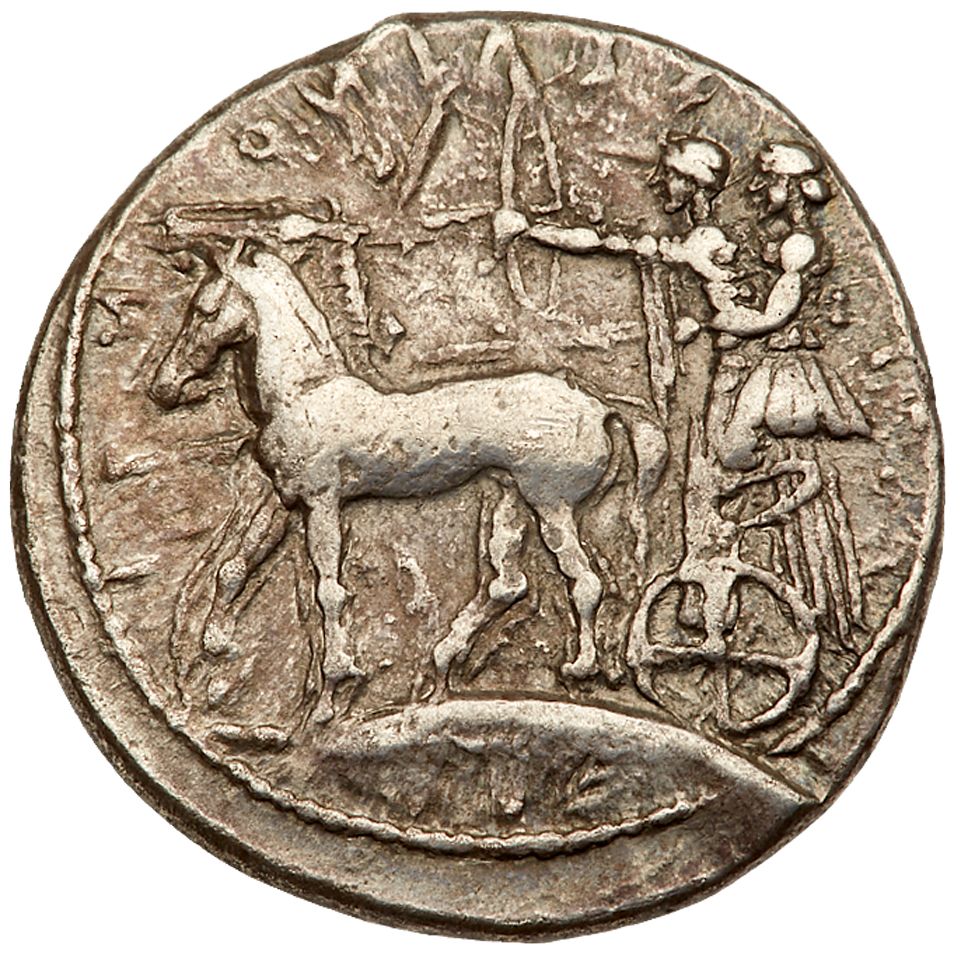 |
Sicily, Selinos. Silver Tetradrachm (17.18 g), ca. 440-430 BC. ΣEΛINO-NTI-ON (retrograde), Artemis, holding reins, driving quadriga left; beside her, Apollo standing, drawing bow; in exergue, grain ear. rev. Σ-EΛ-INONTI-ON, Selinos standing left, holding phiale over altar and laurel branch; on base of altar, rooster standing left; behind, selinon leaf above bull standing left on basis. Schwabacher 6; SNG ANS 688 (same dies); SNG Lloyd 1224 (same dies). Very Rare. Lightly toned. Obverse struck from clashed dies. Choice Very Fine. Estimated Value $2,500
From the Dionysus Collection.
View details and enlarged photos
| Realized
$3,068 |
Lot 44 |
 |
Sicily, Selinos. Silver Tetradrachm (17.24 g), ca. 440-430 BC. ΣEΛIN[O-NTI]-ON (retrograde), Artemis, holding reins, driving quadriga left; beside her, Apollo standing, drawing bow; in exergue, grain ear. rev. Σ-EΛIN-OΣ, Selinos standing left, holding phiale over altar and laurel branch; on base of altar, rooster standing left; behind, selinon leaf above bull standing left on basis. Schwabacher 5 (Q1/S5); SNG ANS 688; SNG Lloyd 1224. Nicely toned. Very Fine. Estimated Value $1,500
View details and enlarged photos
| Realized
$1,652 |
Lot 45 |
 |
Sicily, Syracuse. Deinomenid Tyranny. Silver Tetradrachm (17.45 g), 485-466 BC. Struck under Gelon I, ca. 480/78-475 BC. Charioteer, holding reigns and kentron, driving slow quadriga right; above, Nike flying right crowning horses with wreath. rev. ΣVRAKOΣI-ON, diademed head of Arethusa right, wearing pearl necklace; around, four dolphins clockwise. Boehringer - (V45/R-; rev. die not recorded); Randazzo 257 (same dies). A splendid example of fine archaic style. Boldly struck and well centered. Underlying luster present, all delicately toned. Superb Extremely Fine. Estimated Value $2,000
From the Dionysus Collection.
Despite the legend naming the Syracusans as the issuing authority, this gem of early Classical Syracusan coinage was struck while the city was controlled by the Deinomenid dynasty of tyrants. The dynasty was founded by Gelon, who first assumed power as tyrant in Gela in 491 BC before seizing Syracuse in 485 BC. The expansion of the territory under his control and a great victory over the Carthaginians in 480 BC were instrumental in raising Syracuse to the status of preeminent city in Greek Sicily. The greatness of Syracuse only increased under Gelon's successor, Hieron I. Hieron defeated a combined Carthaginian and Etruscan army at Cumae in 474 BC and won the chariot race events at both the Pythian Games in 470 BC and the Olympic Games in 468 BC, one or both of which might be commemorated by the obverse type of this coin. Unfortunately, the Deinomenid tyranny also became increasingly oppressive under Hieron I and not long after his death in 466 BC, a series of revolutions at Syracuse and other cities overthrew the Deinomenids in favor of new democratic constitutions.
View details and enlarged photos
| Realized
$5,428 |
Lot 46 |
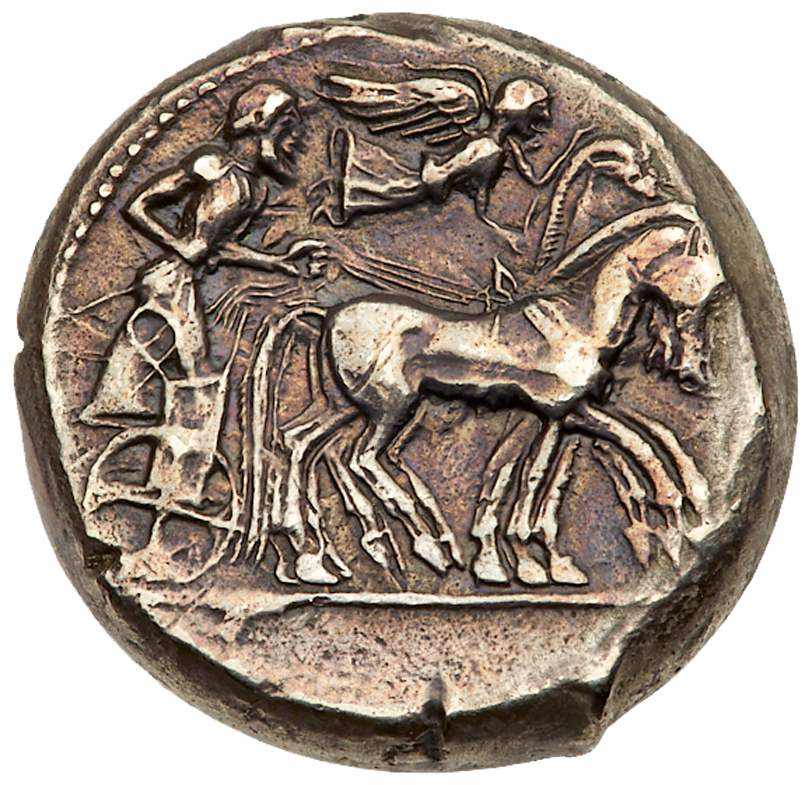 |
Sicily, Syracuse. Deinomenid Tyranny. Silver Tetradrachm (17.07 g), 485-466 BC. Struck under Gelon I, ca. 480/78-475 BC. Charioteer, holding reigns and kentron, driving slow quadriga right; above, Nike flying right crowning horses with wreath. rev. ΣVRAKOΣION, diademed head of Arethusa right, wearing pearl necklace; around, four dolphins clockwise. Boehringer 175 (V75/R122); Randazzo 343 (same dies). Fine archaic style. Attractively toned. Extremely Fine. Estimated Value $1,500
From the Dionysus Collection
Ex Hirsch 267 (5 May 2010), lot 77.
View details and enlarged photos
| Realized
$2,242 |
Lot 47 |
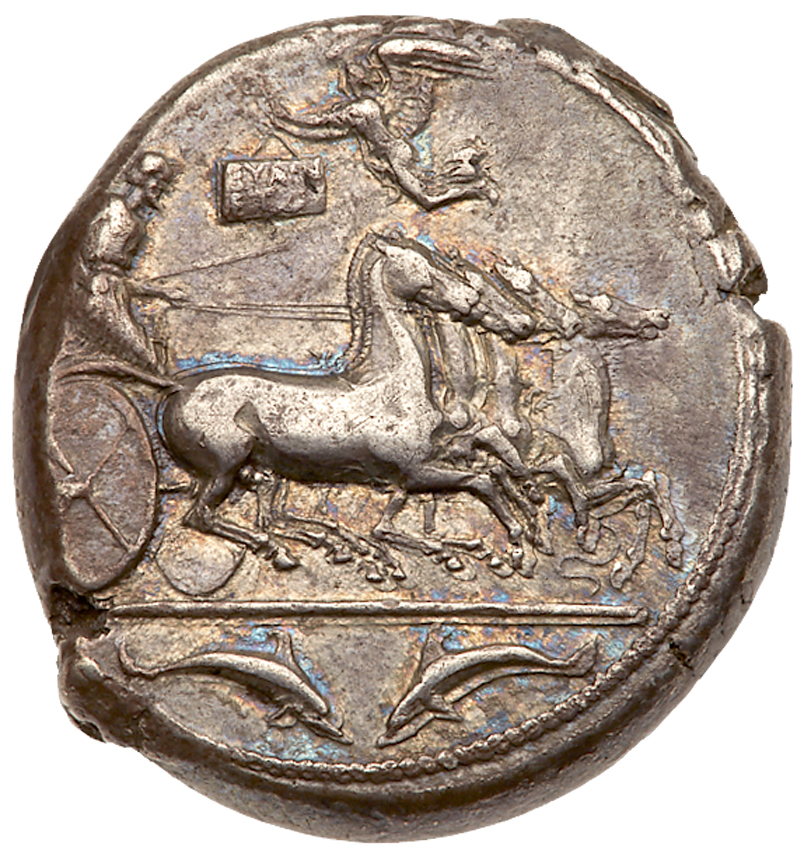 |
Sicily, Syracuse. Second Democracy. Silver Tetradrachm (17.20 g), 466-405 BC. Obverse die signed by Euainetos, reverse die signed by Eumenes. Ca. 413-405 BC. Charioteer, holding kentron and reins, driving galloping quadriga right; above, Nike flying left, holding wreath in both hands, from which hangs tablet inscribed EYAIN/ETO in two lines; in exergue, two dolphins confronted. rev.ΣVPA-KOΣIΩN, Head of Arethousa left, wearing hoop earring and necklace; below, EVMHNOV; around, four dolphins. Tudeer 43 (V14/R25); SNG ANS 270 (same dies); BMFA 408 = Warren 375 (same dies); Dewing 845 (same dies); BMC 148-9 (same dies); de Luynes 1204 (same dies); Ward 279 (same dies). Attractively toned. Slight die-shift on obverse. Nearly Extremely Fine. Estimated Value $3,000
From the Dionysus Collection
Ex Ceresio I (26 September 1987), lot 50.
This tetradrachm, probably struck in the aftermath of the crushing Syracusan victory over the Athenian expedition in 412 BC, belongs to the celebrated signing artists series. While the signature of Eumenes on the reverse is fairly standard in its appearance below the neck truncation of Arethusa, that of Euainetos is quite playful on the reverse. Rather than simply signing his name to the die, the master engraver has modified the standard depiction of Nike above the quadriga so that she carries a tablet inscribed with his name - a brilliant example of the kind of artistic innovation that characterizes much of the signing artists series.
View details and enlarged photos
| Realized
$5,192 |
Lot 48 |
 |
Sicily, Syracuse. Second Democracy. Silver Tetradrachm (17.24 g), 466-405 BC. Charioteer, holding kentron and reins, driving slow quadriga right; above, Nike flying right, crowning horses with wreath; in exergue, ketos right. rev. ΣVRAKOΣI-O-N, diademed head of Arethusa right; around, four dolphins. Boehringer series Xiva, 477 (V255/R342); SNG ANS 148 (same obv. die); Ward 254 (same dies). Lovely old cabinet tone. Well struck on a nice wide flan. Extremely Fine. Estimated Value $2,500
View details and enlarged photos
| Realized
$5,074 |
Lot 49 |
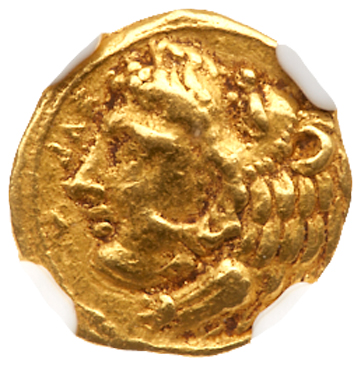 |
Sicily, Syracuse. Dionysios I. Gold 20 Litrai (1.15 g), 405-367 BC. ΣVPA, head of Herakles left, wearing lion's skin headdress. rev. Σ-V-P-A in quarters, in incuse circle within quadripartite incuse square, small female head (Arethusa?) left, wearing necklace. Bérend pl. XI, 3; Boehringer pl. I, 6; Rizzo pl. XLVIII, 7; SNG ANS 351-4. NGC grade XF; Strike: 5/5, Surface: 3/5. Estimated Value $750
View details and enlarged photos
| Realized
$944 |
Lot 50 |
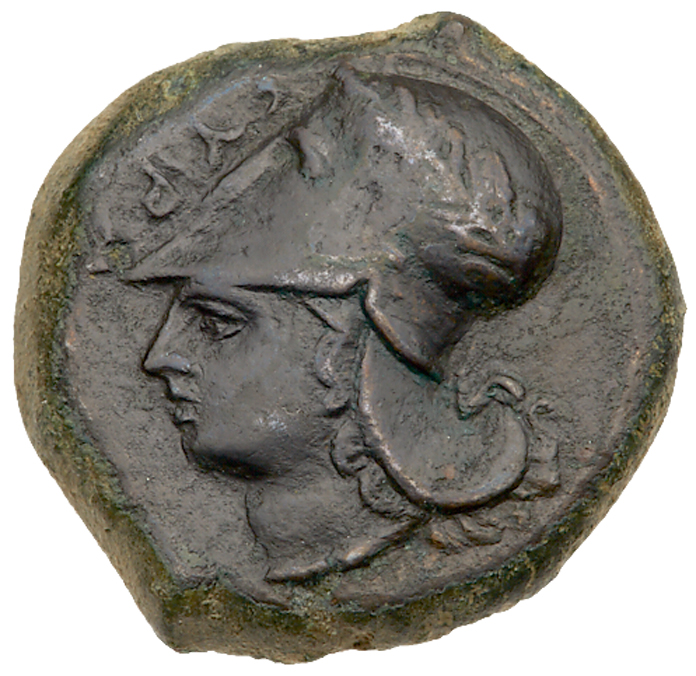 |
Sicily, Syracuse. Dionysios I. Æ Litra (8.11 g), 405-367 BC. ΣYPA, head of Athena left, wearing Corinthian helmet decorated with wreath.rev. Hippocamp left, reins trailing. CNS 45; SNG ANS 434-46. Attractive glossy dark green patina. Choice Very Fine. Estimated Value $200
From the Dionysus Collection.
The Athena / Hippocamp litrae come in several varieties - with and without legend, with and without olive wreath on helmet, with and without a symbol on the obverse, reins trailing and no reins. Calciati notes that this particular variety, with obverse legend and wreath, no symbol and trailing reins, is by far the most common, and also mentions that it is found throughout Sicily, not just in the environs of Syracuse. This wide distribution is anomalous for a bronze coin. Fiduciary in nature and of minimal value, bronze coins in ancient economies did not normally circulate far from their place of minting. Perhaps the reason for the distribution can be found in Dionysios' expansionist policies and nearly perpetual state of warfare with the Carthaginians. Like most armies of the period, Dionysios employed mercenaries, and although mercenary armies were paid in silver, when they were not on campaign they would certainly need small change.
View details and enlarged photos
| Realized
$236 |
|
|